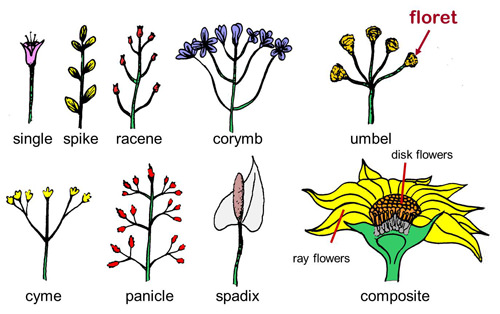Flowers are attractive, colourful and often fragrant structures of flowering plants. They are the primary reproductive organs of the plants. Let’s understand more about the flower structure and morphology.
Suggested Videos
Parts of a Flower
The flower structure is broadly divided into the following parts which are often arranged in a whorled pattern.

Image Source: scienceshorts
Pedicel
This is the stalk of the flower. Plants that have a stalk are known as pedicellate flowers whereas those that do not have a stalk are known as sessile flowers.
Receptacle
This is the base of the flower and lies above the pedicel. It is actually a modified shoot that forms the floral axis and holds the layers of the flower.
Browse more Topics under Sexual Reproduction In Flowering Plants
- Endosperm Development
- Fertilization and Post Fertilization Events
- Gametogenesis in Plants
- Outbreeding Devices and Pollen Pistil Interaction
- Parthenocarpy and Apomixis
- Pollination
- Seeds and Fruits
- Sexual Reproduction
You can download Sexual Reproduction in Flowering Plants Sheet by clicking on the download button below

Calyx
This layer actually forms the first layer in the flower structure. They are said to be modified leaves. ‘Calyx’ is the word given for a collection of sepals. The sepals or calyx are often green in colour. Their main function is to protect the flower while it is still in the bud stage.
Corolla
This forms the second whorl of the flower structure. ‘Corolla’ is the term given for a collection of petals. The petals are the colourful parts of the flower to which the pollinators are attracted to. In many flowers, the Corolla is scented to further make the flower attractive. Like the sepals, the petals are also said to be modified leaves.
The petals are normally arranged in radial symmetry which means the flower can be divided into three equal parts. This type of symmetry is known as actinomorphic symmetry. In other flowers, the petals are arranged bilaterally symmetrical or an irregular pattern and this kind of an arrangement are called zygomorphic symmetry.
The androecium and gynoecium often follow the symmetry seen in the calyx and corolla. The calyx and corolla are collectively called the perianth.
Androecium
The androecium is a term given to the male reproductive system in a flowering plant. It forms the third whorl in a flower. It is made up of one or more stamens. Each stamen is made up of the following parts:
Filament
It is a long slender tube-like structure that holds the anther at the top of it.
Anther
It is the pollen producing part of the plant. It is made up of four chambers or segments known as pollen sacs. The anthers give rise to microspores during their development and each of these microspores forms a pollen grain that carries the male gamete. The nucleus in the pollen grain divided mitotically to form two male nuclei.
The pollen grain has double layered protective coverings. The inner layer is called the intine whereas the outer layer is called the exine. The pollen grains are released by the anthers and they get pollinated to the same flower(self- pollination) or to a different flower(cross-pollination).
The petals, sepals, and the stamens often show fusion to form tubes: Petals fuse to form a tube and this condition is called gamopetalous. Stamens fuse to form a tube called the staminal tube.

Image Source: Florendica
Gynoecium
It forms the fourth whorl of the flower and is often found towards the centre of the flower. This is the female reproductive part of a flower. The gynoecium is a term given to a collection of pistils or carpals. It is made up of the following structures:
- Stigma: It is the sticky end of the style which is responsible for catching pollen when they are pollinated.
- Style: It is a thin tube-like structure that holds the stigma and is attached to the ovary at its base.
- Ovary: It is the swollen basal portion of the flower which houses the ovules which contain the female gamete.
Based on the position of the ovary with respect to the other flower whorls, it can be classified into three types:
- Hypogynous (superior ovary): This type of ovary lies above all the whorls of the flower.
- Perigynous (intermediate ovary): This type of ovary is present in between the other flower layers.
- Epigynous (inferior ovary): This type of ovary is present below the other whorls of the flower. It is often surrounded by the receptacle.
Inflorescence

Image Source: worldoffloweringplants.com
So far we have learned about single or solitary flowers. But, in many plants, the flowers exist in a bunch on a branch along the same or different floral axis. These clusters or bunches of flowers are known as an inflorescence. Though the overall structure of the flowers in an inflorescence remains the same as seen in a solitary flower, the arrangement of these clusters of flowers varies depending on the type of arrangement of the floral axis
Solved Example for You
Question: What is the inner layer of the protective covering of the pollen grain called?
- Intine
- Exine
- Inner integument
- Tesla
Solution: Option A Intine. The inner layer of the protective coat of the pollen grain is the thin intine whereas the tough outer covering is called the exine.






Leave a Reply